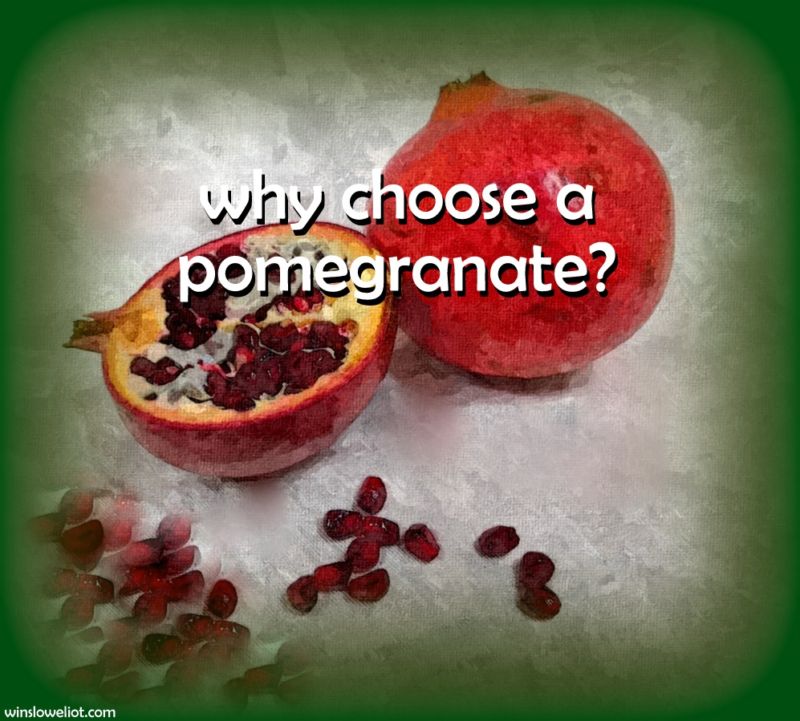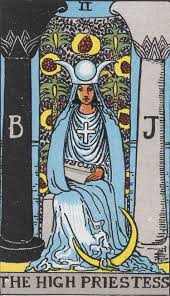
Stillness 10-6: When I was growing up, we always brought at least one pomegranate into our home every autumn because of its seasonal and festive symbolism (although we would eat it too—so delicious!). Its healing medicine works especially well for us at this time of year, in the northern hemisphere, as we head into the darkening of the light.
 In the tarot, the card of the High Priestess is typically represented with pomegranates. In the Rider-Waite depiction of the High Priestess, she is wearing a cross, holding the Torah, has her foot on the moon, and is surrounded by pomegranates. There are two pillars on either side of her, representing the wise and mystical King Solomon’s temple in Jerusalem. The two pillars, Boaz (feminine mysteries of the moon/unconscious/yin) and Joachim (masculine mysteries of the sun/conscious/yang), stand at the entrance to the temple.
In the tarot, the card of the High Priestess is typically represented with pomegranates. In the Rider-Waite depiction of the High Priestess, she is wearing a cross, holding the Torah, has her foot on the moon, and is surrounded by pomegranates. There are two pillars on either side of her, representing the wise and mystical King Solomon’s temple in Jerusalem. The two pillars, Boaz (feminine mysteries of the moon/unconscious/yin) and Joachim (masculine mysteries of the sun/conscious/yang), stand at the entrance to the temple.
Rosh Hashanah—the autumnal new year—is celebrated with a pomegranate.
Pomegranates, deciduous trees originally from Persia and the Himalayas, grow around 25 feet high and can live for 200 years. They produce round-shaped fruit that contain thousands of coral-red juicy, angular seeds that have been revered for thousands of years for their medicinal and healing properties. Nowadays, scientists describe these properties as antioxidants, flavonoids, polyphenols, potassium, vitamin A, C, E, calcium, and iron that are contained in each pomegranate seed.
The fruit (or, officially, the berry) is often associated with the Ancient Greek story of Persephone who was taken by Hades to the underworld. While she was there, she rebelliously refused to eat, but was enticed into eating six pomegranate seeds. Because of this, when she was eventually allowed to visit her mother, Demeter, it could only be for six months, signifying the rebirth of spring and summer, and then the return to the initiatory “death” of autumn and winter months. Pomegranate seeds inspired the secret initiatory rites of the ancient Eleusinian mystery schools in Greece. The initiation has to do with love, fertility, birth, death, and rebirth.
The fruit (or, officially, the berry) is often associated with the Ancient Greek story of Persephone who was taken by Hades to the underworld. While she was there, she rebelliously refused to eat, but was enticed into eating six pomegranate seeds. Because of this, when she was eventually allowed to visit her mother, Demeter, it could only be for six months, signifying the rebirth of spring and summer, and then the return to the initiatory “death” of autumn and winter months. Pomegranate seeds inspired the secret initiatory rites of the ancient Eleusinian mystery schools in Greece. The initiation has to do with love, fertility, birth, death, and rebirth.
In Christian celebrations of weddings and baptisms a pomegranate is often a celebrated gift to the guest of honor. The fruit is associated with the Virgin Mary, eternal life, rebirth, love, and fertility. The Spanish city of Granada is represented by a pomegranate and St. John of God, who founded a hospital there in 1539, used a pomegranate for the hospital’s emblem.
With their deep, blood-red color and the hundreds of mysterious white kernels in each seed, pomegranates always speak of love: “Your lips are like a crimson thread; your mouth is lovely. Your brow behind your veil gleams like a pomegranate split open.” (Song of Songs).
We’re in the heart of the autumn season now. The days are shortening and the nights are cool. What can we do to get ready for the darker and colder days? How can we help each other and ourselves to let go of what we don’t need on this journey into the “innerworld?” We put our garden to bed. We light our inner fire. We can simplify our outer world, and prepare for the inward adventure. Our beloved pomegranate reminds us that love starts from within ourselves. Its sharp, tangy, sweet medicine is the medicine of love.
